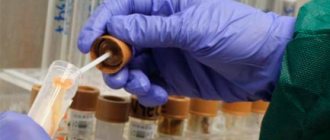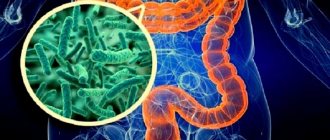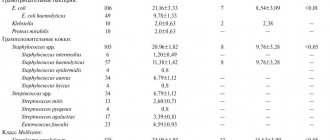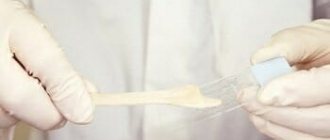Make an appointment
Stool analysis helps to promptly identify a number of problems in the gastrointestinal tract, detect pathogenic flora and prescribe treatment. There are the following options for examining stool: scatological, which allows to identify various pathologies of the gastrointestinal tract (dysfunction of the gallbladder, liver and pancreas, problems of digestion and absorption in the intestines), and microbiological, aimed at identifying the causative agents of intestinal infectious diseases. A number of intestinal infections can also be diagnosed using stool PCR testing. Microbiological examination of stool (culture on the intestinal group of m/o) is mandatory for workers in medical institutions, kindergartens and the food industry. You can take a stool test for a fee in Moscow by contacting one of the IMMA medical clinics.
What is a stool test for the intestinal group?
The test material (stool) is first inoculated on a special nutrient medium with certain conditions favorable for the growth and reproduction of m/o.
After a certain period of time, the microflora from the nutrient media is subjected to microscopic examination. At this stage, it is possible to establish the type of microorganism and its quantity. If a specialist identifies pathogenic pathogens in a certain diagnostically significant quantity, then they are immediately tested for sensitivity to antibiotics.
Stool culture for opportunistic flora with determination of sensitivity to antibiotics
A microbiological study that makes it possible to qualitatively and quantitatively characterize the opportunistic intestinal flora, as well as determine the sensitivity to antibiotics of its individual representatives.
What is this analysis used for?
- To diagnose diseases caused by opportunistic microorganisms and monitor the effectiveness of their treatment.
When is the test scheduled?
- When there is a suspicion of intestinal infections caused by opportunistic microorganisms.
- In the differential diagnosis of disorders of opportunistic flora that occur with similar symptoms.
Synonyms Russian
Opportunistic microorganisms, opportunistic bacteria, opportunistic microbes, opportunistic pathogens, analysis for dysbacteriosis, analysis for UPF.
English synonyms
Opportunistic pathogens, opportunistic flora, opportunistic organisms, antibiotic susceptibility.
What biomaterial can be used for research?
Cal.
How to properly prepare for research?
- The study is recommended to be carried out before starting antibiotics and other antibacterial chemotherapy drugs.
- Avoid taking laxatives, administering rectal suppositories, oils, limit taking medications that affect intestinal motility (belladonna, pilocarpine, etc.) and the color of stool (iron, bismuth, barium sulfate) for 72 hours before stool collection.
General information about the study
Opportunistic flora are microorganisms that are present in humans in moderate quantities. However, under certain conditions, their number increases and exceeds the permissible norm, which leads to corresponding diseases. The most common representatives of opportunistic intestinal flora include: Staphylococcus aureus (S. aureus), Klebsiella, Escherichia, Enterobacter, Citrobacter and Acinetobacter, Proteus, clostridia (Clostridia), serrations (Serratia), pseudomonads (Pseudomonas), yeast-like fungi (Candida, etc.) and other pathogens. These microorganisms can cause infections of the gastrointestinal tract with the development of gastroenteritis, enteritis and enterocolitis.
Stool culture for opportunistic flora with determination of sensitivity to antibiotics is used to diagnose intestinal infections caused by opportunistic microorganisms, as well as to determine the sensitivity of these pathogens to antibiotics.
What is the research used for?
- To identify the causative agent of intestinal infection.
- For differential diagnosis (along with other studies) of diseases that occur with similar symptoms (diarrhea, inflammatory bowel disease, colorectal cancer, diseases accompanied by malabsorption).
- In order to evaluate the effectiveness of antibiotic therapy.
When is the study scheduled?
- For symptoms of intestinal infection.
What do the results mean?
If a moderate growth of opportunistic microorganisms (not exceeding the norm) is observed in the culture, then it cannot be argued that they caused an intestinal infection. Abundant growth of opportunistic microorganisms (exceeding the norm) indicates that they were the cause of the development of infection.
What can influence the result?
Previous antibiotic therapy or chemotherapy, delay in transportation of material to the laboratory lead to a false negative result.
Also recommended
- Stool culture for pathogenic flora (disease group and typhoparatyphoid group) with determination of sensitivity to antibiotics
- Culture for Staphylococcus aureus (S. aureus)
- Culture for Staphylococcus aureus (S. aureus) with determination of sensitivity to antibiotics
- Culture of Candida spp./yeast-like fungi with selection of antimycotic drugs
- Analysis of stool for cysts and vegetative forms of protozoa
- Intestinal dysbiosis with determination of sensitivity to antibiotics
- Coprogram
- Complete blood count (without leukocyte formula and ESR)
Who orders the study?
Therapist, general practitioner, pediatrician, gastroenterologist, infectious disease specialist.
Literature
- Encyclopedia of clinical laboratory tests / ed. N. U. Titsa. – M.: “Labinform”, 1997. – 942 p.
- Guide to infectious diseases / ed. Yu. V. Lobzina, S. S. Kozlova, A. N. Uskova. – St. Petersburg. : Phoenix, 2001. – 932 p.
How to collect stool for analysis
To collect the material, use a sterile container. The container is equipped with a hermetically sealed lid with a special sterile spatula. For analysis, it is enough to take about one teaspoon of feces. The material can be stored for no more than 8 hours in a cool place without freezing.
When collecting stool for subsequent analysis, the following points must be taken into account:
- To empty the intestines, you cannot use an enema or any type of laxative;
- after an X-ray examination of the digestive tract, you need to wait until you take the test, taking a break of at least two days;
- before collecting the material, for 2–3 days you should not take drugs containing bismuth or iron, adsorbent drugs (Smecta, etc.), or administer fat-based suppositories;
- it is necessary to ensure that urine or other biological secretions do not get into the sample;
- During menstruation, the test should be postponed.
You can find out the price of stool analysis for intestinal group or other information about the service in IMMA medical clinics by calling the single call center number listed on the website, or directly from the receptionist.
What is UPF?
The human intestine is home to many bacteria and fungi. They are divided into three groups:
Normal intestinal flora
These microorganisms ensure normal functioning of the intestines. They are necessary and perform many important roles in the digestive process: they protect the intestinal mucosa, promote peristalsis, and produce the necessary enzymes. These include bifidobacteria and lactobacilli, enterobacteria, enterococci, and some E. coli.
Opportunistic flora
Normally, these microorganisms are present in the intestines in small quantities. Normal intestinal flora and local immunity within the intestines prevent them from multiplying too much. However, if the protection of the mucous membrane fails, the proportion of UPF can increase sharply. In this case, inflammation begins, although there was no external infection. UPFs include, for example, streptococci and staphylococci, Helicobacter, and some E. coli.
Pathogenic flora
These are microorganisms that should not be in a healthy intestine at all: salmonella, shigella, vibrio cholerae and others.
Interpretation of results
Normally, the intestinal microflora contains no pathogenic bacteria. The release of virulent microorganisms indicates infection. At the same time, the resistance of bacteria to antibiotics is determined to prescribe the correct treatment.
If there is no growth of pathogenic microorganisms, the result can be considered negative when examining three samples taken at different times.
The results are entered into the patient’s electronic record; the patient can see them in his Personal Account on the company’s website.
How to prepare and collect material
Before donating stool you need to:
- stop taking antibiotics 12 hours before;
- refuse to perform a cleansing enema or take laxatives;
- Before defecation, wash yourself and empty your bladder.
Material in an amount of 5–10 g is collected into a sterile container with a disposable spatula (spatula) from a clean vessel or from a plastic bag. In the presence of blood, mucus captures areas with them. In order for the analysis results to be informative, feces should be delivered to the clinic within 3 hours.
Indications
Stool culture is prescribed for the following purposes:
- detection of intestinal infection (in case of stool disorder in the form of constipation or diarrhea, flatulence, mucus/blood in stool, abdominal pain);
- differential diagnosis with other intestinal pathologies (irritable bowel syndrome, dysbiosis, ulcerative necrotizing colitis);
- monitoring the effectiveness of antibiotic therapy;
- identifying sensitivity to antibiotics of the inoculated pathogen;
- registration of medical records.
Decoding indicators
The interpretation of the results of a stool test for opportunistic microflora includes indicators of the number of certain types of bacteria; it is presented in the form of a table:
| Intestinal microorganism | Age, years | Content standard |
| Bifidobacteria | From 0 to 1 year | 1010 and above |
| Children over 1 year old and adults | 109 and above | |
| Lactobacilli | From 0 to 1 year | 106-107 |
| Children over 1 year old and adults | 107-108 | |
| Escherichia coli (total) | From 0 to 1 year | 107 |
| Children over 1 year old and adults | 108 | |
| Enterobacteria lactose-negative | From 0 to 1 year | 104 |
| Children over 1 year old and adults | 105 | |
| Enterococci | From 0 to 1 year | 105-107 |
| Children over 1 year old and adults | 105-108 | |
| Bacteroides | From 0 to 1 year | 107 |
| Children over 1 year old and adults | 108 | |
| Staphylococcus saprophytes | From 0 to 1 year | Under 104 |
| Children over 1 year old and adults | Under 104 | |
| Clostridia | From 0 to 1 year | Under 103 |
| Children over 1 year old and adults | Less than 105 | |
| Candida | From 0 to 1 year | Under 103 |
| Children over 1 year old and adults | Under 104 | |
| Peptostreptococci | From 0 to 1 year | 103-105 |
| Children over 1 year old and adults | 109-1010 | |
| Staphylococcus aureus | From 0 to 1 year | No |
| Children over 1 year old and adults | No | |
| Enteropathogenic Escherichia coli | From 0 to 1 year | No |
| Children over 1 year old and adults | No | |
| Proteus | From 0 to 1 year | No |
| Children over 1 year old and adults | No | |
| Pathogenic fungi | From 0 to 1 year | No |
| Children over 1 year old and adults | No |
Be sure to read:
Hemolytic Escherichia coli: why is it dangerous and when is therapy needed?
The interpretation and subsequent prescription of treatment, if necessary, is carried out by the attending physician.
Read on the topic: How to restore intestinal microflora at home
Principles of treatment for changes
Changes affecting the results of stool analysis on the UPF are usually manifested by an increase in the number of various opportunistic bacteria above the normal level or the appearance of pathogenic microorganisms. In this case, complex treatment is prescribed, which may include several areas:
- Antibiotic therapy is used to suppress the activity of opportunistic microflora (according to indications) or to destroy representatives of pathogenic flora.
- Probiotics are preparations that contain viable bacteria from representatives of normal flora, mainly bifidobacteria and lactobacilli.
- Prebiotics are drugs that stimulate the activity of beneficial bacteria by containing essential substances.
- General recommendations, including a diet with the exclusion of foods that enhance fermentation processes in the intestines. Preference is given to fermented milk products, as well as plant products containing fiber.
The duration of complex treatment is determined by the doctor individually. Typically, after a course of therapy, control laboratory tests may be prescribed, including stool analysis for UPF.
In continuation of the topic, be sure to read:
- Details about the coprogram: preparation, conduct and interpretation of the analysis
- Representatives of normal (useful) intestinal microflora: maintenance standards
- Stool analysis for calprotectin: what does it show and how to take it?
- Stool analysis for scatology: preparation, submission and interpretation of the study
- Analysis of feces for carbohydrates in infants: delivery and interpretation of readings
- Analysis of stool for disgroup: essence, preparation and delivery of analysis
- Taking a stool test for dysbacteriosis + interpretation
- Preparing and submitting a stool test for dysbacteriosis in infants
- Blood test for parasites: delivery and interpretation of indicators
- Fecal analysis for worms and their eggs: preparation and implementation
In what cases is culture for dysbacteriosis usually prescribed?
Cultures for dysbacteriosis are carried out to identify imbalances in the intestinal microflora and are based on determining the quantitative composition of the main bacteria inhabiting the intestines. The results obtained are compared with normal values. In order to assess the dynamics of indicators, stool culture for dysbacteriosis is carried out no earlier than 2 weeks after the end of therapy with antibiotics or bacteriophages.
Dysbacteriosis (imbalance of normal intestinal flora) in adults and children can be associated with disruption of the liver, biliary tract, stomach, and pancreas.
Signs of dysbiosis may accompany the following conditions:
- parasitic infestations, including giardiasis;
- chronic infections, for example, carriage of staphylococcus;
- allergies;
- hypovitaminosis;
- diabetes;
- after taking antibiotics.
Intestinal dysbiosis can manifest itself as constipation, diarrhea, flatulence, pain and other disorders.









